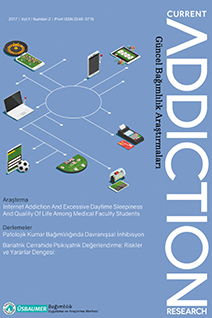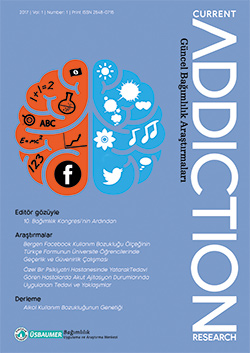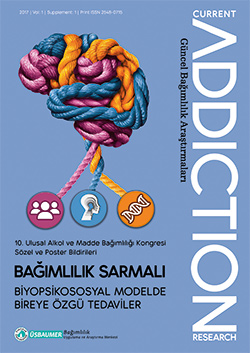Years
2025
Categories
Authors
ARTICLES
Original Article
Başak Ünübol,Gizem Akülker,Berhudan Şamar,Kursad Nuri Baydili
2025, 9(1), s:53-65
İntroduction: Research has identified many characteristics that may influence women's progression from use to addiction and their struggle with recovery. In previous studies, it was reported that 2.9-3.2% of the applicants to addiction treatment centers in Turkiye were women. Considering the low rate of women applying to treatment compared to men, it was thought that examining the completion of treatment would make an essential contribution to the literature. At the same time, there is no recent study on the descriptive characteristics of women in inpatient addiction treatment centers in our country and the factors affecting treatment completion.
Method: Our study was conducted by examining the data of 104 female patients who were treated as inpatients with a diagnosis of alcohol or substance use disorder according to DSM-5 in an Addiction Detox Clinic of a Mental Health Hospital. During inpatient treatment, withdrawal severity is assessed according to the type of substance, and the necessary detoxification medication is administered according to the CIWA-R or COWS scales. All participants completed the Addiction Profile Index (API) scale. The data were analyzed using the SPSS-27 package program. Frequency tables for sociodemographic questions were created. Regression analysis was applied to see the effect of the independent variable on the dependent variable. The analyses were applied with alpha level = 0.05.
Results: The mean age of the participants was 31.5 years, the primary substance of use at the time of admission to treatment was alcohol at 45% and substance at 55%, and the frequency of use was every day at 93%. Having a family history of alcohol or substance abuse was 49%. 47% were single, judicial history was 37%, 73% were unemployed, 59% had a history of comorbid mental illness, 35% had a history of suicide attempts in the past, 54% of the participants had multiple substance use, and 22% had a history of intravenous substance use, even if only once in their lives. The early discharge rate was 38%, and sociodemographic and clinical variables were not statistically significant. It was observed that the API scale was statistically highly correlated with non-completion of treatment, especially in individuals with high 'severe craving' sub-dimension scores.
Conclusion: Considering that women have a low rate of applying for addiction treatment, it is important to understand the needs of women patients who apply for treatment to complete the treatment and to include gender-specific intervention programs in the treatment.



 2. Sayı
2. Sayı
 1. Sayı
1. Sayı
 Ek Sayı
Ek Sayı







